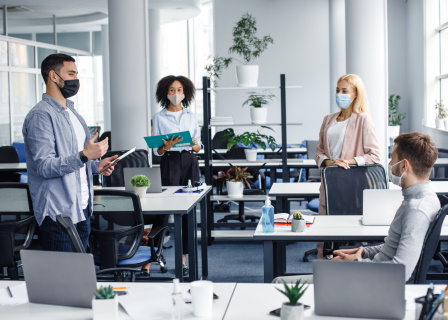5 Ways in Which the Pandemic Changed the Modern Office

There’s nothing in recent history that has changed the corporate landscape more than COVID-19. It’s hard to believe, but we have now been dealing with the pandemic for more than a year now. It’s changed how we communicate, how we educate our children – and yes – how we go to work.
For some of us who are considered “essential workers” the pandemic meant carrying on with business as usual, but with many more restrictions in place. That includes a change in office interior, increased sanitation, the requirement to wear masks, and enforcing social distancing rules amongst employees. For those in other industries that are not considered essential, it means pivoting to a new way of doing the job that allows employees to remain remote and physical offices to be transitioned to virtual environments or low-contact areas. Here are five ways in which COVID-19 has impacted the corporate workplace.
Home Offices Are the New Corporate Offices
Had COVID-19 struck a decade ago, the modern corporate worker might not have been able to pivot so easily to a home environment. However, in 2021 we have the required internet speed, modern technology, and all the communication tools (Zoom, Google Hangout, etc.) in order to conduct meetings in our own homes just as we would in an office environment.
If the pandemic has taught us anything, it’s that we actually don’t need centralized corporate offices for workers to effectively do their jobs and communicate with co-workers and customers. We can do this from home just as long as we have a reliable internet connection and computer. For some companies, this has meant putting more of an investment towards IT, but it’s been a worthwhile investment knowing that employees can transition from an office to a home work environment without missing a beat.
Changes in Interaction
The biggest culture shock to most people in the wake of the pandemic was changing the way we interact. Virtually all face-to-face interactions migrated to video, email, or chat, which can be difficult when it comes to tone and social cues. The transition has also been a challenge for those who have held off on modern communication technologies, especially with older demographics who may have been reluctant before to use them. The companies who have been successful in their pivot were the ones that identified early that communication needed to be treated as a top priority and made a point to get their employees up to speed.
Now that face-to-face interaction at the office is no longer an option, many companies are employing regular team check-ins via video conference so that employees can continue getting interaction.
Corporate Real Estate is No Longer in High Demand
Before the pandemic, every company felt like they needed an office because the idea of work-from-home hadn’t been put into practice yet. Now that work from home has proven successful, corporate leadership is now realizing that the value of a physical office isn’t as essential or as valued as it originally was. What this has led to is many corporations either scaling down their physical workspace or eliminating it entirely, thus, saving on their bottom line. By cutting down on their leasing costs, companies can push that money towards their employees with higher salaries, better benefits, or other improvements.
As we move forward in 2021 and the vaccine is widely distributed, we may see more companies opt to scale down their physical offices, even though they could technically return back to normal.
Addition of Flex Space
A lot of companies are still obligated to keep their office space because I can’t get out of their lease agreement. This means that they have office space but they can’t use all of it due to COVID-19 protocols – mainly social distancing. The compromise is the implementation of a flex workspace, which means companies can still have their employees come in, but they’re not assigned designated areas or cubicles. This is great for employees who have a home environment that is too busy or too loud to allow them to work from home. The flex work space has also been beneficial for employees that need to be able to come in and collaborate in person, which can sometimes be hard to do over chat or video conference.
Creative Floor-planning
Some companies who have had the same layout in their offices for several years have had to reexamine their floorplan in the wake of the pandemic. This means moving cubicle walls and rearranging offices so that employees are afforded the personal space that needed to meet social distancing protocols. Companies are also buying protective screens and partitions to cut down on any potential interoffice spread of the virus. The idea here is that if employees absolutely have to come in, the risk needs to be mitigated through the use of space and separation. For instance, many companies that were once using low cubicle walls are opting for the higher versions that measure 5’ or more in height.
Need Help Planning and Furnishing Your Office Space? We Can Help!
Santa Fe Office Interiors has been diligently working with corporations who are redesigning their workspace and employees shifting to a home office environment. We sell new and used office furniture here in the Kansas City area, including partitions, desks, office chairs, and anything you may possibly need for a corporate or home office environment.
The best way to see what we can offer you is by visiting our store at 8106 Santa Fe Dr. in Overland Park, KS. We always keep a large stock and wide variety of products on our showroom floor.
If you’d like to set an appointment, call us at 913-901-8800.
